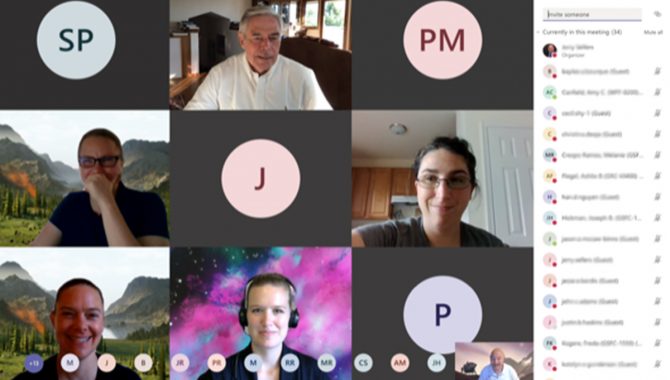
In response to the Coronavirus pandemic, APPEL KS quickly and successfully converted more than 80 percent of its courses, such as Project Management and Systems Engineering above, to virtual delivery to help NASA’s technical workforce meet their training needs.
Credit: NASA/APPEL KS
APPEL KS retools courses to reach teleworking technical workforce.
On Tuesday, March 17, 2020, as the country was coming to grips with how widespread and destructive the Coronavirus pandemic was becoming in the United States, NASA elevated all centers and facilities to Stage 3 on its Response Framework, meaning that virtually all employees and contractors were on mandatory telework until further notice.
“When I realized in-person training was going to be impossible, I met with the curriculum team to look for alternatives,” said Roger Forsgren, NASA’s Chief Knowledge Officer and APPEL’s Director. Forsgren understood that although NASA’s Centers were closing, important work on NASA’s major missions was still moving forward.
“Most programs and projects weren’t shutting down; they were working remotely. We needed to continue supporting these teams. The NASA workforce faces incredible technical, budgetary and scheduling issues and we need to do everything we can to help them as they have to face this new, additional challenge of working remotely,” Forsgren said.
The transition was so swift that the first virtual course APPEL KS completed was also the last face-to-face one that it started.
On March 13, the curriculum team was halfway through the eight-day-long Project Management and Systems Engineering course at Marshall Space Flight Center. Another of NASA’s Centers—Ames Research Center—had already gone to mandatory telework at the beginning of that week. By that weekend, it was becoming increasingly clear that the pandemic would significantly change how the Agency—and the nation—worked. The instructor of the course flew home to Colorado that weekend and quickly improvised a way to deliver the second half of the course online the following week.
“That’s how we got thrown into virtual training,” said Donna Wilson, APPEL KS’s Curriculum Manager.
“I told our team we need to look at this situation as an opportunity,” Forsgren recalled. “While the NASA technical workforce is required to work remotely, we need to use this to our advantage and utilize their time the best way we could by offering virtual courses. The only guidance I gave our team was that quality comes first. If a course would suffer due to converting it to virtual, we won’t do it.”
The team looked at what had been the schedule of upcoming face-to-face courses and applied three criteria for the conversion to virtual delivery—shorter duration courses; limited reliance on extensive team activities and other classroom interactions; and vendors with the flexibility and capability to adapt to virtual delivery quickly.
The curriculum team initially identified 34 courses for virtual delivery through July. While adapting and delivering those, they continued evaluating the remaining courses, eventually identifying another 16, to reach a total of 50 courses—81 percent of APPEL KS’s course catalog.
By any measure, the rapid transition has been a success. During April, May, and June, APPEL was able to deliver more courses virtually than were originally scheduled face-to-face. Attendance and wait list numbers are both up during that period compared to 2019. There have been no course cancellations because of low enrollment. And feedback has been positive.
Lessons learned during the process include that attendees favored courses that were delivered over more days, but with shorter screen time on each of those days. That enabled them to balance more effectively their shared domestic responsibilities. Other lessons learned are that virtual courses require more advanced preparation, drive equipment needs, have a longer learning curve to implement, and require enhanced marketing efforts.
The team overcame those challenges and more to reach this level of success. APPEL KS—like other federal entities, school systems, and private sector companies—went through several iterations before finding technical platforms with the right combination of performance and security. The team also learned that the technology component of virtual courses requires a producer in addition to an instructor.
“Our team and our instructors did a great job converting the courses to a virtual format and also in working the inevitable IT glitches involved with online training,” Forsgren said. “And, the NASA workforce did a great job transitioning to learning online. I think most people prefer the in-person experience but, facing the cold facts of a pandemic, they were patient and helpful and, I think, even a bit grateful that they could use this time to get the necessary training they needed.”
The team found that attendees were willing and eager to help their colleagues and instructors as they worked through new technologies to make the courses happen. “It was very much an atmosphere of ‘we’re all in this together.’ They understood the difficulties and that we were all learning the technologies together,” Wilson said.
Virtual delivery opened the door for APPEL KS to hold regional courses in which attendees from multiple Centers can attend the same course. “Normally we have a course that is limited to one Center. But we started doing these regional courses—west coast, central, eastern—and people commented on how nice it was to be able to interact with other Centers. They’d be on a team working on a certain exercise or case study and they’re hearing how another Center does it. That was a real plus,” Wilson said.
As the pandemic continues, APPEL KS has built a solid foundation for continued virtual training for as long as it is necessary. Wilson said the curriculum team is examining the remaining course catalog for other opportunities and is also planning to pilot a new course virtually and gather feedback on it.
“As horrible as this pandemic has been, we tried to make the best out of it and use it as an opportunity to expand our training footprint,” Forsgren said. “Online training is here to stay. When the pandemic is over, we’ll work with the Centers and Mission Directorates to evaluate what our customers want. I imagine we’ll be offering courses both in-person and virtually.”









